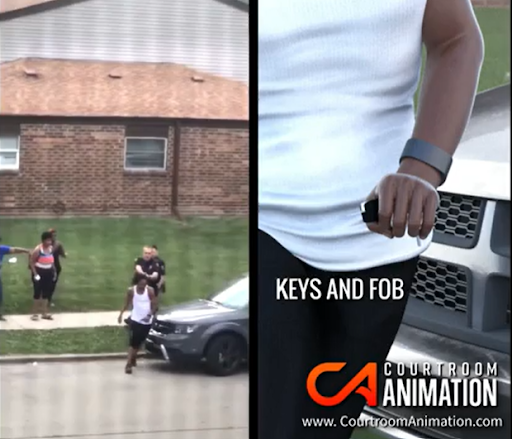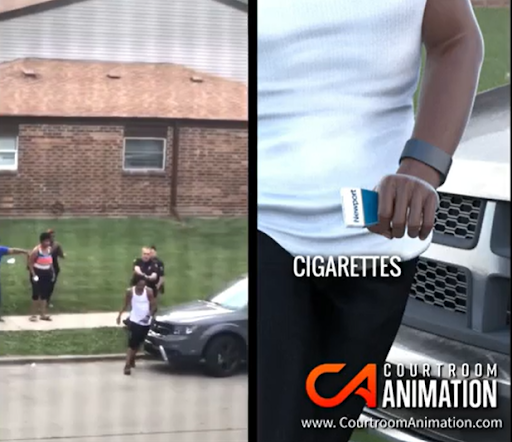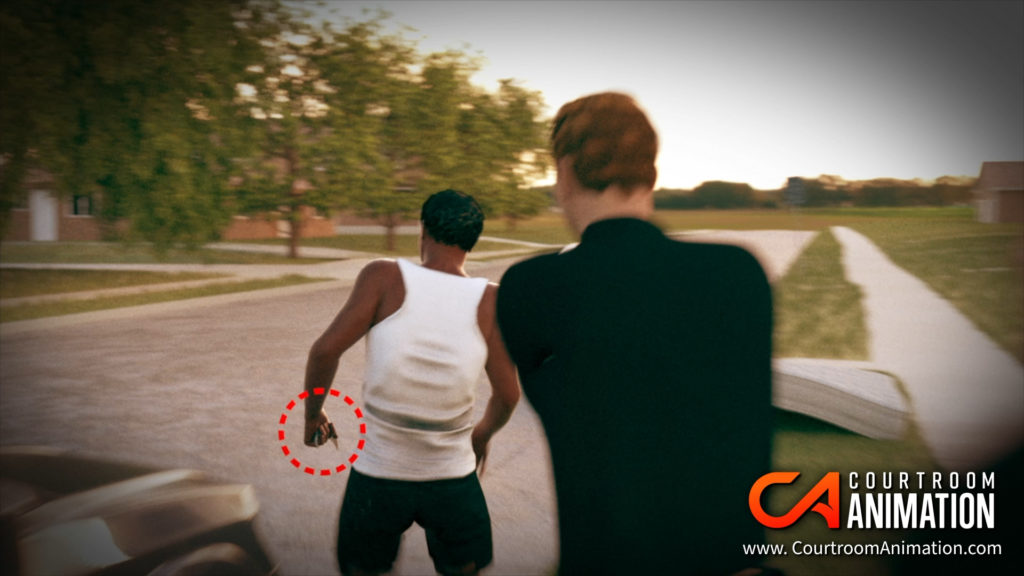“The Courtroom Animation team was a pleasure to work with. They were incredibly diligent and accurate with the work throughout this case. The visuals produced by them were of high quality and instrumental in helping my client.”
– Brendan Matthews, Defense Attorney at Cermele & Matthews
Summary:
In Wisconsin in 2020, in a case which gained national attention, a police officer shot a man multiple times after engaging in a physical altercation. There were multiple witnesses, and video footage from two cell phones was recorded at the scene.
Courtroom Animation was retained by the officer’s defense attorney to create various forensic animations of the incident, some of which were reported on by TMJ4 News. The animations accurately re-created and analyzed the events leading up to, during, and after the shooting, which demonstrated the officer’s difficult and split-second decision to fire his service weapon.
The forensic analysis and accompanying visualizations assisted the Wisconsin Department of Justice and the District Attorney’s office in evaluating the situation, including the officer’s actions, the actions of the surrounding officers, and those of the injured man. Based on the facts and available data, the District Attorney found that no federal criminal civil rights violations occurred, and thus declined to file charges.
The Challenge:
There were many viewpoints and questions that each of the involved parties had to address. Given the high-profile nature of this case and the wide range of witnesses and evidence, separating out the key facts from conjecture and speculation was incredibly challenging. The two videos captured the incident from very different angles, and at a very low level of quality. Sorting out the bias from the many witness perspectives proved to be enormously difficult.
The Solution: Forensic Animations of the Incident – Before & After
There was controversy about what the man had held in his hands while he approached his vehicle and before the police officer fired his weapon. Cell phone footage revealed that he was holding something, but it was unclear how it affected the officer’s quick decision to use lethal force. A knife had been found at the scene, but there was no confirmation whether that was the object in question.
Watch our CEO, Brady Held, discuss the animations while retained on this high-profile officer-involved shooting case.
The forensic analysis of the potential objects the man could have been holding was a crucial factor in this case. Using photogrammetry techniques and measurements of common handheld objects, our team of animators digitally replaced the object in his hand with various 3D models of other items. After determining that it could not have been several objects, such as cigarettes or car keys, the analysis’ outcome confirmed that it was a knife. This supported the defense’s statement that there was a life-threatening situation which gave cause for the police officer’s actions.


Additionally, the cell phone footage recovered from nearby witnesses was grainy and unstable, making it hard to process on its own. Courtroom Animation’s team thoroughly analyzed the footage, frame by frame, to create a digestible and non-dramatized animation, which helped instill a better understanding of events.
For example, for the District Attorney’s office to fully comprehend the factors involved in the shooting, the visuals demonstrated the moments leading up to the shots being fired. The forensic animations highlighted the officer’s perspective when, as the man walked to the driver’s car door, the police officer saw the knife in the man’s hand. This weapon elevated the situation’s threat level, and contributed to explaining why he made a split-second decision to fire his weapon.

As a high-profile shooting case, it was important that the animations also visualized the events that occurred before the cell phone recordings took place. To do this, we built an accurate 3D model of the scene composed of 125 million data points from laser scanning, and then supplemented this with animations based on witness perspectives. These additional visuals added crucial context for the case’s review, including the fact that there were three young children in the back of the vehicle during the altercation.
3D Camera Model Positioning Used to Recreate Officer-Involved Shooting Animations
Result: No Charges Filed
Our experienced animators used video recreation and multiple forensic analysis techniques to accurately recreate this tragic scene, separating facts from conjecture in an emotionally charged case. Ultimately, these demonstrative visuals, paired with other facts and real evidence from the scene, helped support the notion that willful excessive force was not used by the officer in question.
As a result, there were no charges filed against the defendant.
Courtroom Animation’s team of visual strategists, animators, and developers can create your 3D forensic animation for any case regarding police shootings, car accidents, personal injury, medical malpractice, product liability, and more.
Learn how our officer-involved shooting animations, or other forensic animations, can assist your defense case today.